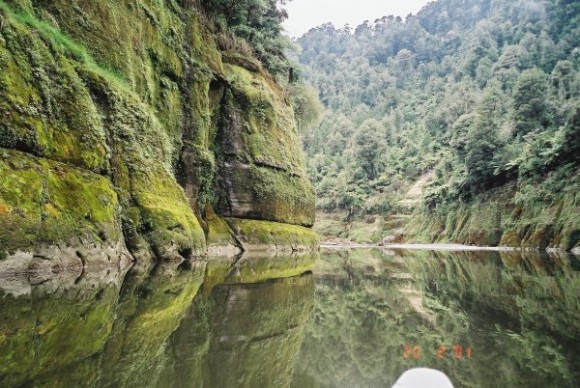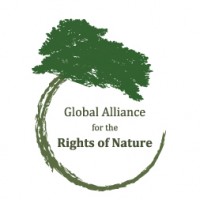
Rivers and Natural Ecosystems as Rights Bearing Subjects
by: Global Alliance for the Rights of Nature, Robin Milam Posted on: January 06, 2013
Photo: Ron Mertons, Whanguanui River
Editor’s Note: Should nature be integrated into our social contracts? Should we be empowered to dissent on her behalf? Read on to learn where these ideas have already been implemented. Written by the Administrative Director for the Global Alliance for the Rights of Nature, this piece is filed under our Community Rights section because some argue that communities have a right to grant rights to the natural ecosystems they depend upon.
In a historic preliminary agreement between the Whanganui Iwi (Maori people) and the New Zealand Crown (Elizabeth II) announced in August 2012, the Whanganui River is being granted legal personhood rights. The river is a major commercial route on the North Island and is sacred to the Iwi. The proposed agreement, which has taken decades of negotiation, assigns shared guardian responsibilities for the river to the Iwi and officials representing the Crown. This landmark move is a first for New Zealand but not for the world.
Across the Pacific, Ecuador’s Vilcabamba River has also been recognized as a rights bearing subject of the law. In 2008 Ecuador became the first country in the world to include Rights of Nature in its Constitution. The Constitution states that Nature “… has the right to exist, persist, maintain and regenerate its vital cycles, structure, functions and evolutionary processes.” Furthermore, the people of Ecuador have the legal authority and responsibility to enforce these rights on behalf of ecosystems including rivers. In 2011, a major development project impacted the flow of the Vilcabamba River. Local residents filed a suit against the developer on behalf of the river. At the conclusion of a court trial, the river won. The judge awarded damages to the river and restoration is currently in process.
Granting legal standing to natural ecosystems is not isolated to these two cases. Recognizing Rights of Nature and natural ecosystems is the focus of a global grassroots movement. In 2010 in Cochabamba, Bolivia over 35,000 climate justice, indigenous rights, human rights and other civil society activists came together at the Peoples Conference for Climate Change and the Rights of Mother Earth and acclaimed the Universal Declaration for Rights of Mother Earth. A copy of the declaration with 120,000 supporting signatures was presented to UN Secretary-General Ban Ki-moon at the Rio+20 Earth Summit in June 2012. Also in 2010, the Global Alliance for the Rights of Nature was formed to provide a global hub for empowering the movement.
The premise of recognizing Rights of Nature has been advanced for decades through the writings of Thomas Berry1, Cormac Cullinan2, Christopher Stone3 and others. Nonetheless, nature as a rights bearing subject of the law took root in 2006 in the small rural community of Tamaqua Borough, Pennsylvania, USA. In less than a decade almost three dozen communities in the United States have passed local laws that recognize Rights of Nature. In addition to the United States and Ecuador, Rights of Nature laws are being implemented in Bolivia and proposed in other countries.
The story of Tamaqua Borough is an example of one of the ways communities from Maine to Washington State and California are organizing to assert Rights of Nature. Coal has provided the economic base for the Borough of Tamaqua for much of the last century. As coal mining in the region declined, mining companies began to look for other sources of profit by using their abandoned mine pits as toxic waste dumpsites. Industrial waste and agricultural sludge or “biosolids” were being dumped into the large unlined pits. In time, toxic waste began to leach into the surrounding rivers and aquifers. When residents learned the coal companies planned to fill the pits with fly ash—the poisonous dust residue from coal mining—they rallied together. Attempting to protect their community, the Borough Council had an abrupt awakening as they began to understand that the environmental regulatory systems did not provide protection they so desperately wanted and needed. Because the rivers and aquifers had no standing in the law and the contaminating pits were owned by the mining corporations, the community had no recourse for protecting themselves or their local ecosystems under the current laws and regulatory system. The permit process permitted the contamination.
With the assistance of Community Environmental Legal Defense Fund (CELDF.org), Tamaqua Borough passed a rights-based ordinance that recognized the rights of the natural ecosystems that were being polluted and the rights of the community to decide on issues affecting them. The ordinance declares that “It shall be unlawful for any corporation…to interfere with the existence of natural communities or ecosystems or to cause damage…Ecosystems shall be considered to be ‘person’ for the purpose of enforcement.” The Borough of Tamaqua and its residents are granted standing to represent natural communities and ecosystems.4
Other communities are driven by a variety of galvanizing issues. The City of Pittsburgh, PA has passed a local ordinance recognizing the rights of the local ecosystems and natural communities while limiting corporate personhood rights, so as to prevent hydrofracking within the City. For Santa Monica, CA a resolution including recognition of the Rights of Nature is part of the City’s overall Sustainability Plan. In Shapleigh, Maine, the City Council moved to protect the city’s ground water resources from corporate extraction and exploitation, to bar companies such as Nestle from bottling its water. Food sovereignty, the Tar Sands pipeline, threat of toxic contamination, and other emerging issues are uniting communities to stand for the rights of both their human and natural communities.
The move is a fundamental change from the current position of most modern legal systems, which treat nature as property to be bought, sold, and consumed often under commerce laws. The underlying Rights of Nature premise recognizes our human interdependence with the natural ecosystems we are a part of. These interrelated values are integral to ancient indigenous wisdom around the world but are ignored by modern law’s anthropologic framework.
This is a movement that transcends political values and ideologies. If you are inclined to assume the movement is the work of a bunch of left winged progressive tree huggers, think again. Many of the cities and townships in the US who have embraced Rights of Nature are conservative, right wing communities. Citizens across diverging political ideologies are emboldened to take a stand once they fully understand that the U.S. Constitution and/or current environmental protection laws do not protect the natural communities which sustain healthy, human life or our rights as communities to make the quality of life choices that are ours to make.
The time has come to recognize that We the People are an integral part of the natural communities that sustain us. It is time to recognize the rights of our natural ecosystems not only to exist, but to sustain their natural, healthy balance for the benefit of all life.
For more information on Rights of Nature and the foundational principles behind the movement:
- Global Alliance for Rights of Nature: http://therightsofnature.org/
- Community Environmental Legal Defense Fund (CELDF): http://celdf.org/
- Rights of Mother Earth Signature Campaign: http://www.thepetitionsite.com/1/yes-to-rights-of-nature//
Books and Articles:
1. Book: The Great Work: Our Way into the Future by Thomas Berry http://www.amazon.com/The-Great-Work-into-Future/dp/0609804995
2. Book: Wild Law: A Manifesto for Earth Justice: by Cormac Cullinan http://www.chelseagreen.com/bookstore/item/wild_law:paperback
3. Book: Should Trees Have Standing? by Christopher Stone http://www.amazon.com/Should-Trees-Have-Standing-Environment/dp/0199736073
4. Book: Be The Change: How to Get What You Want in Your Community: http://www.amazon.com/Be-The-Change-What-Community/dp/1423605616
5. Collection of Essays: Rights of Nature: Planting Seeds of Real Change down load free at http://www.globalexchange.org/communityrights/resources/rioreport
One Response to “Rivers and Natural Ecosystems as Rights Bearing Subjects”
Articles On Community Rights
Community Rights:
- May 19 Part 2: Jordan Cove LNG Backers Spend Huge Money to Sway Tiny Oregon County Election
- May 2 Part 1: Oregon County Faces Gas Industry Funding, Lobbyists in Battle to Halt Jordan Cove LNG Project
- Jan 12 For Teachers and Citizens: How to Respond to Federal Immigration Raids
- Jan 5 How To Respond When Your (Local) Government Gets Sued By A Corporation
- May 25 Interview: The Working Class Movement Fighting for Local Authority
- Apr 29 Interview: Challenging Corporations’ ‘Right’ To Grow GMOs in Rural Oregon
- Nov 3 Cancer Clusters Spark Historic Pesticide Vote in Oregon
- Dec 8 The Devil In The Details of Local Law
- Dec 8 Don’t Tread On Us-A Message from Colorado
- Dec 8 Making Sense of Recent Legal History
- Dec 8 Where Push Is Coming To Shove, USA
- Nov 8 The First Big Win for the $15 Movement
- Nov 8 A Legal Definition for ‘Unsustainable Energy’?
- Oct 8 When The State Pushes Back
- Oct 8 This Crow Won’t Fly
- Oct 8 A New County Constitution
- Sep 8 Homeless Bills of Rights-New Narratives
- Sep 8 Colorado Anti-fracking Movement Heating Up!
- Sep 8 Local Initiative Process Gutted
- Aug 8 Obstacles to Asserting Rights
- Aug 8 Benton County, OR Moves Forward with Nation’s Potential First Food Bill of Rights
- Jul 8 Spokane Continues to Fight for the Right to Vote
- Jul 8 Foster Youth Bill of Rights, New Narratives
- Jul 8 Santa Monica Passes West Coast’s First Rights of Nature Ordinance
- Jun 8 Housing Justice: Fighting for Rights
- Jun 8 A Community Rights Ordinance For South Puget Sound
- Jun 8 County Government Writes History, Hydrocarbon Ban is First of its Kind
- Jun 8 Food Bills of Rights and Monsanto-Speech
- Jun 6 GM Wheat Discovered in Oregon, Benton County Continues Work on Food Bill of Rights
- May 8 Does Food Sovereignty Exist in the United States? Food and the Community Rights Movement
- May 8 Washington Community Action Network Talks Rights
- Apr 7 Under the Radar: How a Multinational Corporation Quietly Bought a County-Wide Election
- Apr 2 Day One of the Occupation of Detroit
- Mar 25 Crude Oil Trains Proposed for Grays Harbor, WA: Citizens Challenge Permitting Process
- Mar 18 Middle School Elevates its Rights above Corporations’
- Mar 12 What a Difference a Degree Makes
- Mar 2 The Story of Broadview Heights, Ohio
- Feb 17 Democracy Denied in Small Town, USA
- Feb 4 The View from Plymouth, NH
- Jan 27 Benton County’s Fight to Protect Our Seed Heritage: A Food Bill of Rights
- Jan 16 Fighting for the Right to a Sustainable Food System: Benton County, Oregon
- Jan 6 Rivers and Natural Ecosystems as Rights Bearing Subjects
- Dec 31 Case Study: The Community Right to Sustainable Energy
- Dec 24 Barnstead, NH: Establishing the Community Right to Water and Self-Governance
- Dec 19 New Section: Community Rights
- Sep 23 Changing ‘Fundemental Law’, a Case Study: Bellingham
- Mar 29 The Right to Self-Govern



by: Valerieon: Friday 25th of January 2013